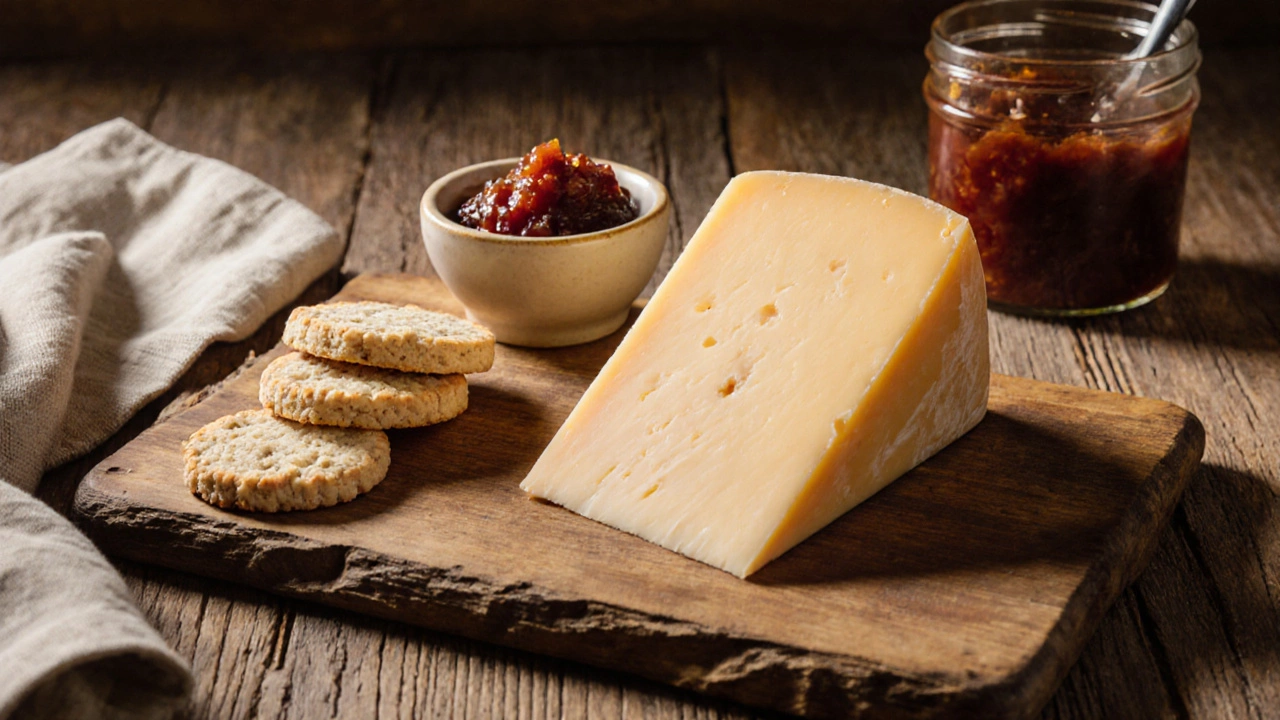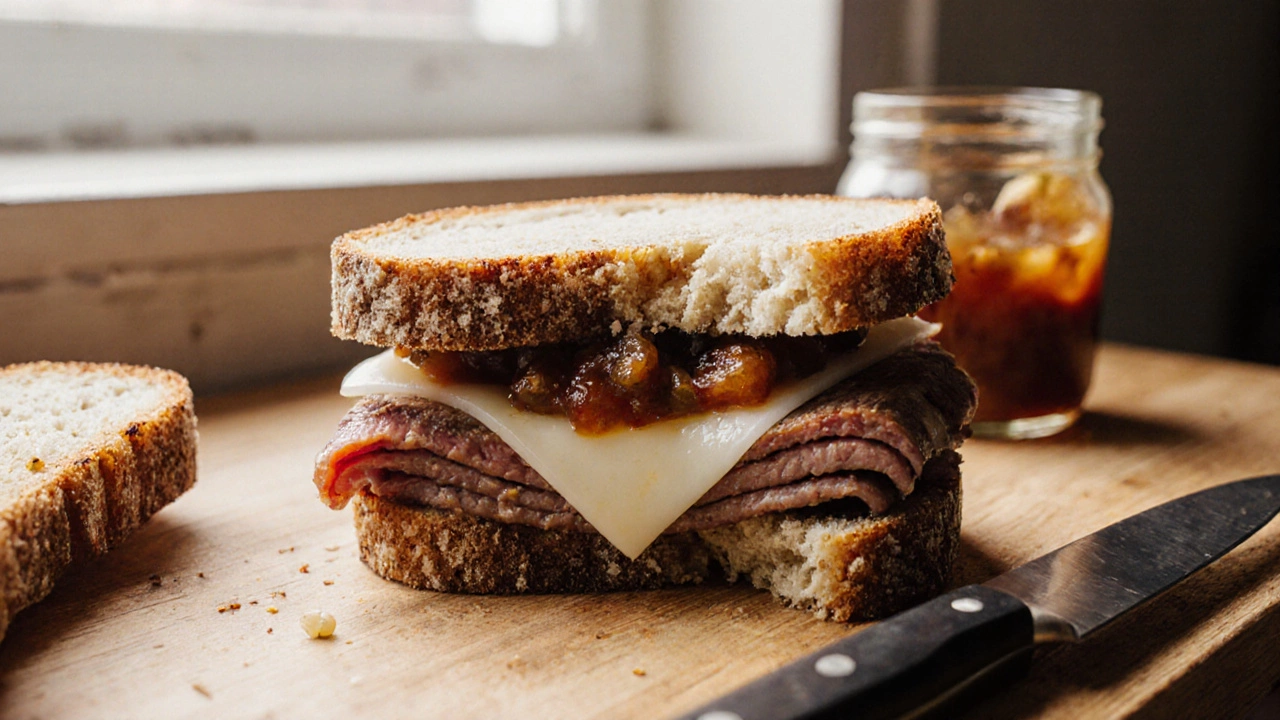How to Eat British Chutney: Simple Ways to Enjoy It with Everyday Foods
16 November 2025

Chutney Pairing Calculator
Find Your Perfect Chutney Pairing
Select your food type and chutney variety to discover the best match based on flavor profiles.
British chutney isn’t something you spoon straight from the jar-unless you’re having a really bad day. It’s a condiment built to lift other foods, not dominate them. Think of it like hot sauce or mustard: it’s there to add punch, depth, and a little sweetness or tang to something plain. And if you’ve ever opened a jar of British chutney and wondered what to do with it beyond putting it on a cracker, you’re not alone.
Start with Cheese
The most classic way to eat British chutney is with cheese. It’s not just a British thing-it’s a British chutney thing. A sharp cheddar, a creamy brie, or even a mild gouda all sing when paired with a spoonful of mango, onion, or apple chutney. The sweetness cuts through the fat, and the vinegar balances the salt. Try it on a charcuterie board: a thick slice of mature cheddar, a few crackers, and a dollop of red onion chutney. That’s it. No fancy tools. No cooking. Just good food.
Don’t limit yourself to hard cheeses. Soft cheeses like camembert or goat cheese love chutney too. Warm the cheese slightly under the broiler, then top it with a spoonful of spiced plum chutney. The heat softens the cheese and wakes up the spices in the chutney. It’s the kind of snack that turns a quiet evening into something special.
Use It in Sandwiches and Wraps
Most people think of mustard or mayo when they make a sandwich. But British chutney? It’s better. It adds texture, flavor, and a little complexity that spreads like mayo never can. Try it on a turkey and swiss sandwich. Or pile it between slices of sourdough with roast beef and horseradish. The chutney ties the meat and bread together without overwhelming either.
It works in wraps too. Spread a thin layer on a whole wheat tortilla before adding grilled veggies, hummus, and feta. The chutney adds a sweet-spicy note that makes the whole thing feel more interesting. And because it’s thick, it doesn’t make the wrap soggy like tomato or sauce might.
Pair It With Cold Meats and Pâtés
If you’ve ever had a British Sunday roast, you’ve probably seen chutney on the side of the plate, next to the gravy and Yorkshire pudding. But it doesn’t just belong with roast beef. It’s just as good with cold cuts. A slice of ham, a spoonful of chicken liver pâté, and a dollop of apple and walnut chutney? That’s a perfect bite. The chutney cuts the richness of the pâté and adds a little crunch if it’s got bits of fruit or nuts in it.
Try it with salami or prosciutto. Wrap a thin slice of meat around a cube of cheese, then dip it lightly in chutney. It’s like a mini appetizer you can make in seconds. No fork needed.
Use It as a Glaze or Sauce Base
Chutney isn’t just a side. It can be a cooking ingredient. Mix a couple of tablespoons into your barbecue sauce for a sweet-tangy twist. Stir it into plain yogurt for a quick dip for grilled chicken or vegetables. Or use it as a glaze for roasted pork or duck. Brush it on in the last 10 minutes of cooking-it caramelizes nicely and sticks to the meat like a glaze.
Even in vegetarian dishes, it works. Toss cooked lentils or chickpeas with a spoonful of tamarind chutney and a splash of lemon. It turns a simple bowl into something with layers of flavor. You don’t need spices or herbs-just the chutney does the work.

Try It With Breakfast
Yes, breakfast. British chutney doesn’t just show up at dinner. Spread it on toast instead of jam. It’s less sweet than jam, but more interesting. Try it with scrambled eggs and buttered toast. Or dollop it on top of a breakfast burrito with beans and cheese. Even a plain bagel with cream cheese gets a boost from a spoonful of mango chutney.
And if you like your porridge or oatmeal with fruit, try stirring in a teaspoon of chutney. The spices-cinnamon, ginger, cloves-work well with oats. It’s not traditional, but it’s delicious. And if you’ve got kids who won’t eat fruit, this is a sneaky way to get them to taste something sweet and spicy without realizing it.
Don’t Forget the Biscuits and Crackers
Crackers are the easiest way to use chutney. But not just any crackers. Go for plain, buttery ones-like water biscuits or plain saltines. The flavor of the chutney needs a quiet partner. Avoid heavily seasoned crackers. They’ll fight with the chutney.
Try it with cheese straws or oatcakes. The crunch of the cracker and the soft, sticky texture of the chutney make a nice contrast. And if you’re serving guests, put a small bowl of chutney next to a cheese platter. People will gravitate toward it. It’s one of those things that feels fancy but takes zero effort.
What Not to Do
Don’t use chutney as a dip for raw vegetables. It’s too thick and sweet. Carrots and celery want hummus or ranch, not mango chutney. Don’t microwave it unless you’re using it as a glaze-heat changes the texture and can make it too runny. And don’t assume all chutneys are the same. Some are sweet, some are spicy, some are vinegary. Taste it first. If it’s too sour, balance it with a little honey. Too sweet? Add a splash of vinegar.

Store It Right
Once opened, keep your chutney in the fridge. Most last 3-6 months. If you see mold, throw it out. If it smells off-like alcohol or vinegar gone bad-don’t risk it. The sugar and vinegar preserve it, but they’re not magic. Always use a clean spoon. Never double-dip.
Where to Find It
You can buy British chutney in most supermarkets now-especially in the international aisle or near the cheeses. Brands like Branston, Sharwood’s, and Crosse & Blackwell are common. But if you want something more interesting, look for small-batch makers. Some local food markets or online shops sell chutneys with unusual ingredients: beetroot and ginger, pear and cardamom, or even fig and port wine.
And if you’re feeling adventurous, make your own. It’s easier than you think. Simmer fruit, vinegar, sugar, and spices for an hour. Let it cool. Bottle it. You’ll have more flavor than anything you can buy.
Can you eat British chutney on its own?
Technically yes, but it’s not meant to be. British chutney is very sweet, sour, and spicy all at once. Eating it straight from the jar can be overwhelming. It’s designed to balance other foods-like cheese, meat, or bread-not to be the star.
Is British chutney the same as Indian chutney?
No. Indian chutneys are usually fresh, made daily, and eaten right away. They’re often herb-based, like cilantro or mint, and have a bright, raw flavor. British chutney is cooked, preserved, and aged. It’s thicker, sweeter, and more like a jam or relish. They share roots, but they’re different foods now.
What’s the best chutney for beginners?
Start with mango chutney. It’s the most common, mildly sweet, and not too spicy. It pairs well with cheese, sandwiches, and even yogurt. Once you’re comfortable, try red onion or apple chutney-they’re more complex but still approachable.
Does British chutney expire?
Unopened, it can last 1-2 years in a cool, dark place. Once opened, keep it refrigerated and use it within 6 months. Always check for mold, off smells, or changes in texture. If it looks or smells wrong, toss it.
Can you freeze British chutney?
Yes, but it’s not usually necessary. The vinegar and sugar preserve it well in the fridge. If you do freeze it, transfer it to a freezer-safe container, leaving space for expansion. Thaw it in the fridge overnight. The texture might soften slightly, but the flavor stays the same.
Next Steps
Grab a jar of chutney this week. Don’t wait for a special occasion. Try it on toast with peanut butter. Mix it into your morning yogurt. Add it to a grilled cheese sandwich. You’ll be surprised how much flavor it adds to simple meals. British chutney isn’t fancy. It’s practical. It’s the kind of thing that turns an ordinary meal into something worth remembering.